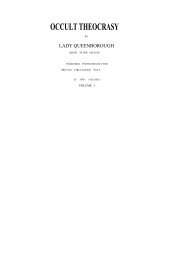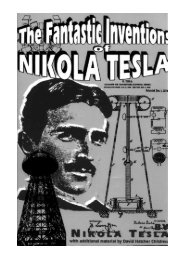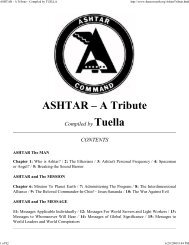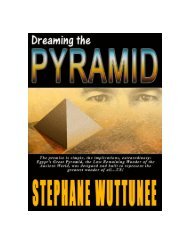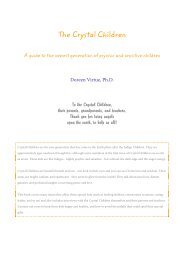the fantastic inventions of nikola tesla - Exopolitics Hong Kong
the fantastic inventions of nikola tesla - Exopolitics Hong Kong
the fantastic inventions of nikola tesla - Exopolitics Hong Kong
Create successful ePaper yourself
Turn your PDF publications into a flip-book with our unique Google optimized e-Paper software.
<strong>the</strong> nature <strong>of</strong> <strong>the</strong>se phenomena. Each day we go to our work in <strong>the</strong> hope <strong>of</strong> discovering,—in <strong>the</strong> hope that some<br />
one, no matter who, may find a solution <strong>of</strong> one <strong>of</strong> <strong>the</strong> pending great problems,—and each succeeding day we return<br />
to our task with renewed ardor; and even if we are unsuccessful, our work has not been in vain, for in <strong>the</strong>se<br />
strivings, in <strong>the</strong>se efforts, we have found hours <strong>of</strong> untold pleasure, and we have directed our energies to <strong>the</strong> benefit<br />
<strong>of</strong> mankind.<br />
We may take—at random, if you choose—any <strong>of</strong> <strong>the</strong> many experiments which may be performed with alternating<br />
currents; a few <strong>of</strong> which only, and by no means <strong>the</strong> most striking, form <strong>the</strong> subject <strong>of</strong> this evening's demonstration;<br />
<strong>the</strong>y are all equally interesting, equally inciting to thought.<br />
Here is a simple glass tube from which <strong>the</strong> air has been partially exhausted. I take hold <strong>of</strong> it; I bring my body in<br />
contact with a wire conveying alternating currents <strong>of</strong> high potential, and <strong>the</strong> tube in my hand is brilliantly lighted.<br />
In whatever position I may put it, wherever I may move it in space, as far as I can reach, its s<strong>of</strong>t, pleasing light persists<br />
with undiminished brightness.<br />
Here is an exhausted bulb suspended from a single wire. Standing on an insulated support, I grasp it, and a platinum<br />
button mounted in it is brought to vivid incandescence.<br />
Here, attached to a leading wire, is ano<strong>the</strong>r bulb, winch, as I touch its metallic socket, is filled with magnificent<br />
colors <strong>of</strong> phosphorescent light.<br />
Here still ano<strong>the</strong>r, which by my fingers' touch casts a shadow—<strong>the</strong> Crookes shadow, <strong>of</strong> <strong>the</strong> stem inside <strong>of</strong> it.<br />
Here, again, insulated as I stand on this platform, I bring my body in contact with one <strong>of</strong> <strong>the</strong> terminals <strong>of</strong> <strong>the</strong> secondary<br />
<strong>of</strong> this induction coil—with <strong>the</strong> end <strong>of</strong> a wire many miles long—and you see streams <strong>of</strong> light break forth<br />
from its distant end, which is set in violent vibration.<br />
Here, once more, I attach <strong>the</strong>se two plates <strong>of</strong> wire gauze to <strong>the</strong> terminals <strong>of</strong> <strong>the</strong> coil, I set <strong>the</strong>m a distance apart, and<br />
I set <strong>the</strong> coil to work. You may see a small spark pass between <strong>the</strong> plates. I insert a thick plate <strong>of</strong> one <strong>of</strong> <strong>the</strong> best<br />
dielectrics between <strong>the</strong>m, and instead <strong>of</strong> rendering altoge<strong>the</strong>r impossible, as we are used to expect, I aid <strong>the</strong> passage<br />
<strong>of</strong> <strong>the</strong> discharge, which, as I insert <strong>the</strong> plate, merely changes in appearance and assumes <strong>the</strong> form <strong>of</strong> luminous<br />
streams.<br />
Is <strong>the</strong>re, I ask, can <strong>the</strong>re be, a more interesting study than that <strong>of</strong> alternating currents? In all <strong>the</strong>se investigations, in<br />
all <strong>the</strong>se experiments, which are so very, very interesting, for many years past—ever since <strong>the</strong> greatest<br />
experimenter who lectured in this hall discovered its principle—we have had a steady companion, an appliance<br />
familiar to every one, a plaything once, a thing <strong>of</strong> momentous importance now— <strong>the</strong> induction coil. There is no<br />
dearer appliance to <strong>the</strong> electrician. From <strong>the</strong> ablest among you, I dare say, down to <strong>the</strong> inexperienced student, to<br />
your lecturer, we all have passed many delightful hours in experimenting with <strong>the</strong> induction coil. We have watched<br />
its play, and thought and pondered over <strong>the</strong> beautiful phenomena which it disclosed to our ravished eyes. So well<br />
known is this apparatus, so familiar are <strong>the</strong>se phenomena to every one, that my courage nearly fails me when I<br />
think that I have ventured to address so able an audience that I have ventured to entertain you with that same old<br />
subject. Here in reality is <strong>the</strong> same apparatus, and here are <strong>the</strong> same phenomena, only <strong>the</strong> apparatus is operated<br />
somewhat differently, <strong>the</strong> phenomena are presented in a different aspect. Some <strong>of</strong> <strong>the</strong> results we find as expected,<br />
o<strong>the</strong>rs surprise us, but all captivate our attention, for in scientific investigation each novel result achieved may be<br />
<strong>the</strong> centre <strong>of</strong> a new departure, each novel fact learned may lead to important developments.<br />
Usually in operating an induction coil we have set up a vibration <strong>of</strong> moderate frequency in <strong>the</strong> primary, ei<strong>the</strong>r by<br />
means <strong>of</strong> an interrupter or break, or by <strong>the</strong> use <strong>of</strong> an alternator. Earlier English investigators, to mention only<br />
Spottiswoode and J. E. H. Gordon, have used a rapid break in connection with <strong>the</strong> coil. Our knowledge and<br />
experience <strong>of</strong> to-day enables us to see clearly why <strong>the</strong>se coils under <strong>the</strong> conditions <strong>of</strong> <strong>the</strong> tests did not disclose any,<br />
remarkable phenomena, and why able experimenters failed to perceive many <strong>of</strong> <strong>the</strong> curious effects which have<br />
since been observed.<br />
In <strong>the</strong> experiments such as performed this evening, we operate <strong>the</strong> coil ei<strong>the</strong>r from a specially constructed alternator<br />
capable <strong>of</strong> giving many thousands <strong>of</strong> reversals <strong>of</strong> current per second, or, by disruptively discharging a condenser<br />
through <strong>the</strong> primary, we set up a vibration in <strong>the</strong> secondary circuit <strong>of</strong> a frequency <strong>of</strong> many hundred thousand or<br />
millions per second, if we so desire; and in using ei<strong>the</strong>r <strong>of</strong> <strong>the</strong>se means we enter a field as yet unexplored.<br />
It is impossible to pursue an investigation in any novel line without finally making some interesting observation or<br />
learning some useful fact. That this statement is applicable to <strong>the</strong> subject <strong>of</strong> this lecture <strong>the</strong> many curious and<br />
unexpected phenomena which we observe afford a convincing pro<strong>of</strong>. By way <strong>of</strong> illustration, take for instance <strong>the</strong><br />
most obvious phenomena, those <strong>of</strong> <strong>the</strong> discharge <strong>of</strong> <strong>the</strong> induction coil.



